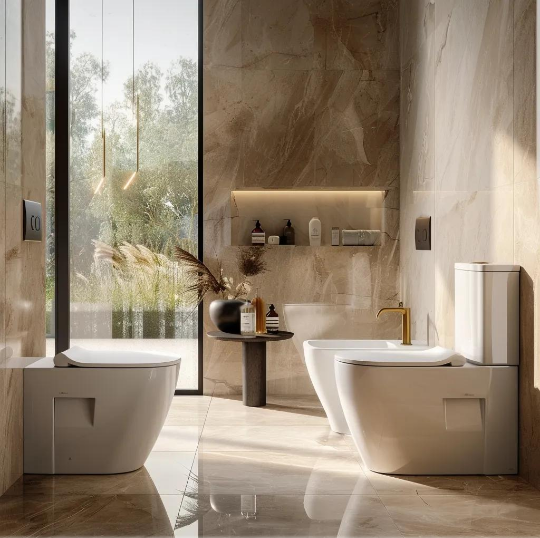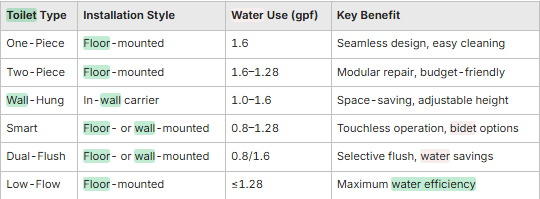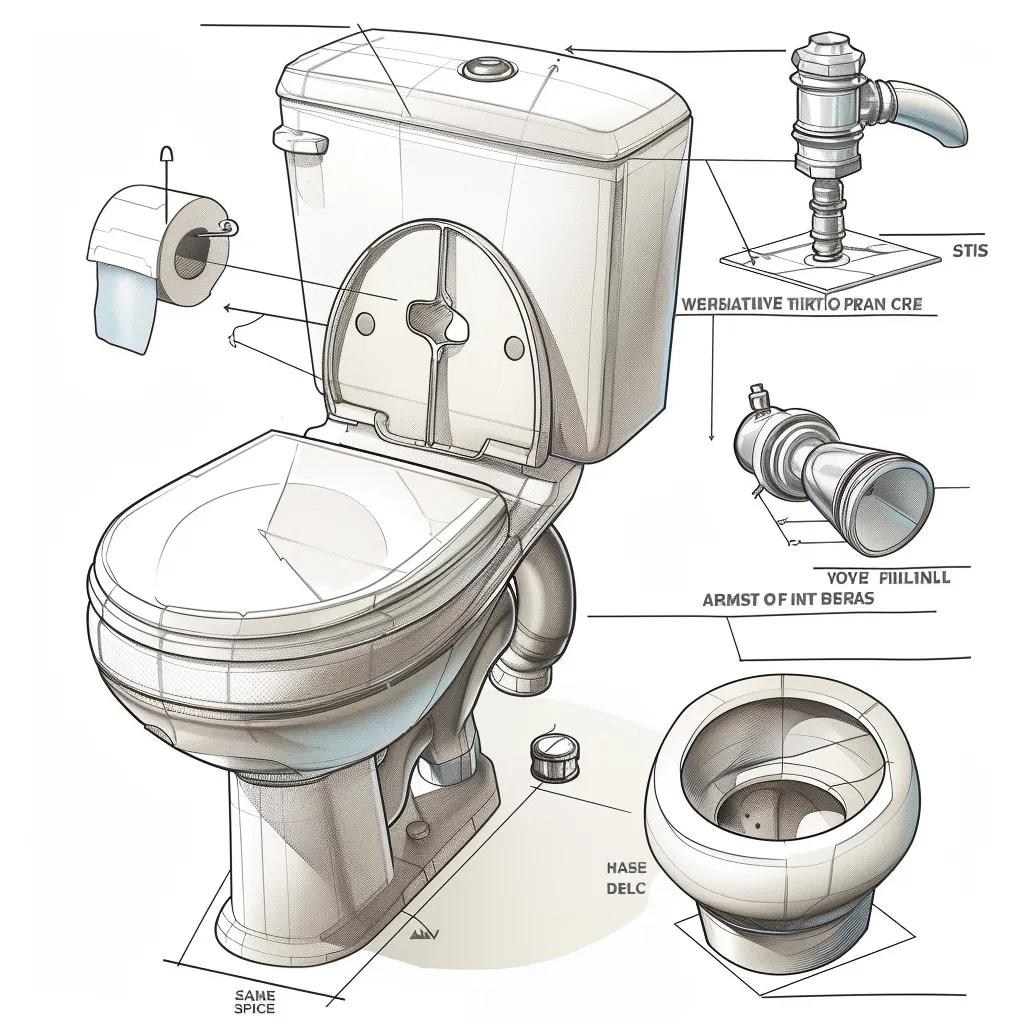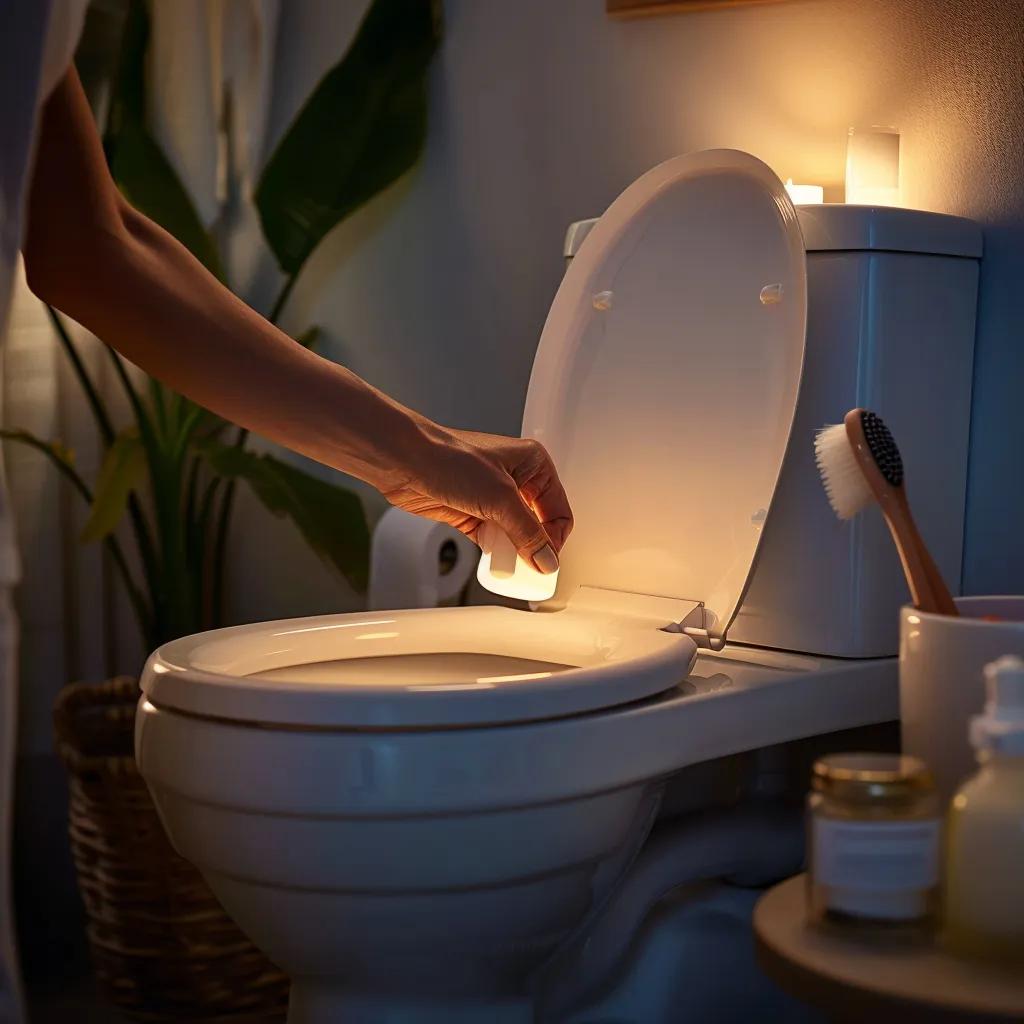
What to know about Toilets?
A reliable toilet is the centerpiece of any bathroom, yet its intricate design and variety of styles often go unnoticed until a problem arises. Understanding toilet types, flushing mechanics, common issues, and maintenance can save time, water, and money while improving hygiene. In this guide, you will discover:
- The major toilet types and their advantages
- How a toilet’s cistern, bowl, trap, flush valve, and fill valve work together
- Troubleshooting leaks, clogs, constant running, weak flushes, and noise
- Essential maintenance routines for hygiene and longevity
- Key factors when choosing and installing a toilet
- The benefits of bidet toilets and attachments
- Answers to top toilet questions from Mitchel Plumbing and Gas experts
Mitchel Plumbing and Gas brings decades of local expertise in installations, repairs, and preventive care to ensure your toilet performs flawlessly and conserves water.
What Are the Different Types of Toilets and Their Benefits?
Toilet types vary by design, installation method, water efficiency, and technology to suit diverse bathroom layouts and user needs. Recognising each type’s features and benefits helps you choose the right fixture for comfort, sustainability, and style.
What Is a One-Piece Toilet and When Is It Ideal?
A one-piece toilet integrates the bowl and cistern into a single ceramic unit, simplifying cleaning and minimising leaks at the joint. This seamless design enhances durability, offers a sleeker profile for modern bathrooms, and reduces installation complexity. Homeowners seeking a low-maintenance fixture with fewer crevices choose one-piece toilets for consistent performance and easier sanitation.
How Does a Two-Piece Toilet Compare to Other Models?
A two-piece toilet features a separate bowl and tank connected by bolts and a gasket, allowing easier transport and replacement of individual parts. Its modular construction often makes repairs more affordable, tank or bowl can be swapped without full replacement. Two-piece toilets offer a balance of cost-effectiveness and reliable flushing, making them a popular choice for family bathrooms.
What Are the Advantages of Wall-Hung Toilets?
Wall-hung toilets mount to a concealed in-wall carrier, elevating the bowl above floor level for a minimalist, space-saving design. This mounting system simplifies floor cleaning, reduces footprint, and hides the cistern within the wall for a streamlined look. Compact bathrooms benefit from wall-hung toilets’ adjustable bowl height and modern aesthetic.
How Do Smart Toilets Enhance Bathroom Hygiene and Convenience?
Smart toilets integrate features such as automated flushing, heated seats, built-in bidets, self-cleaning nozzles, and air deodorisers. These electronic fixtures elevate hygiene by minimising touchpoints and customising wash settings. Households prioritising luxury and sanitation appreciate smart toilets for personalised comfort and advanced water-saving cycles.
What Makes Dual-Flush Toilets Water Efficient?
Dual-flush toilets offer two flush options typically a half-flush for liquid waste and a full-flush for solids. By allowing selective water use, they reduce average consumption by up to 67% compared to single-flush models. Dual-flush toilets certified by EPA WaterSense deliver performance while cutting water bills and preserving resources.
Why Choose Low-Flow Toilets for Sustainability?
Low-flow toilets use 1.28 gallons per flush or less, leveraging optimised bowl shapes and pressure-assisted mechanisms to maintain flushing power. They conserve thousands of gallons of water annually without sacrificing functionality. Environmentally conscious homeowners and businesses select low-flow toilets to meet green building standards and lower utility costs
To compare key attributes of these six toilet types, consider the following table:

This overview highlights how design and flush technology influence installation and resource use, setting the stage for understanding the plumbing behind each flush.
How Does a Toilet Work? Understanding Key Components and Flushing Mechanisms

A toilet relies on coordinated action between its cistern, bowl, trap, flush valve, and fill valve to remove waste and refill for the next use. Grasping these mechanisms underpins effective troubleshooting and service decisions by professionals like Mitchel Plumbing and Gas.
What Is the Role of the Toilet Cistern in Flushing?
The toilet cistern stores a measured volume of water used for each flush. When the flush lever or sensor activates the flush valve, stored water surges into the bowl, generating the siphon that clears waste. The cistern’s tank design and valve placement determine flush strength and water retention, making precise water-level calibration essential for optimal performance.
How Does the Toilet Bowl and Trap Work Together?
The toilet bowl holds waste and directs it through the built-in trap, a curved channel that retains a water seal to block sewer gases. During flushing, water force overcomes the trap’s curvature, siphoning contents into the drain line. The water seal then reseals automatically, preserving hygiene and odor control.
What Are Flush Valve and Fill Valve Functions?
The flush valve controls the rapid release of cistern water into the bowl during a flush, while the fill valve opens to refill the cistern after flushing. A well-sized flush valve maximises water flow for efficient waste removal, and a properly adjusted fill valve ensures consistent tank refill without overflows or chattering noises.
How Does Water Flow Through the Toilet During a Flush?
When activated, water flows from the cistern through the flush valve into the bowl’s rim jets and siphon jet, creating combined wash and siphon action. Waste travels through the trap into the drainpipe, and the fill valve then restores cistern level via a refill tube. This cycle readies the toilet for the next use while maintaining the water seal. Understanding these plumbing fundamentals paves the way for diagnosing leaks, clogs, and malfunctioning fill mechanisms.
What Are Common Toilet Problems and How Can You Troubleshoot Them?
Toilet malfunctions often manifest as leaks, clogs, running water, weak flushes, or distracting noises. Systematic troubleshooting can resolve minor issues, while Mitchel Plumbing and Gas stands ready for complex repairs and code-compliant solutions.
How Do You Fix a Leaky Toilet?
A leaky toilet typically occurs at the base or from the tank-to-bowl joint. Tightening mounting bolts, replacing the wax ring seal beneath the bowl, or installing a new tank-to-bowl gasket restores a watertight connection. If cracks appear in porcelain components, professional replacement ensures lasting reliability.
What Steps Can You Take to Unclog a Toilet?
Begin with a flange plunger to create alternating pressure and suction, dislodging blockages in the trap. For stubborn clogs, a plumbing auger snakes through the trap into the drain to break up debris. Chemical-free drain tablets can help prevent buildup, but regular mechanical clearing avoids damage to pipes.
Why Is My Toilet Running Constantly and How Can I Stop It?
Continuous running usually stems from a worn flapper valve, misaligned fill tube, or improperly adjusted float. Inspect the flapper for warping and replace if it fails to seal. Position the fill tube above the overflow tube and adjust the float level to shut off the fill valve when the cistern reaches the correct height.
What Causes a Weak Flush and How Is It Resolved?
A weak flush often results from mineral buildup in rim jets, low water level in the cistern, or a clogged siphon jet. Cleaning rim holes with vinegar, verifying full tank volume, and clearing the siphon jet hole beneath the bowl restores flush power. Upgrading to a pressure-assisted or optimised gravity-fed model can further enhance performance.
How Can You Identify and Fix Noisy Toilets?
Hissing or vibrating noises indicate fill valve chatter or water hammer. Replacing the fill valve with a quiet-fill model and adding a water hammer arrestor on supply lines mutes disruptive sounds. Loose bolts or an unseated fill tube can also cause rattling, resolved by tightening connections.
When Should You Call a Professional Plumber for Toilet Repairs?
Do call Mitchel Plumbing and Gas when leaks persist after seal replacement, supply lines tremble under pressure, or toilet components require removal and reset. Professional expertise ensures compliance with plumbing codes, precise rough-in measurements, and durable repairs that protect against water damage.
Resolving these common problems extends toilet lifespan and preserves sanitation before advancing to routine maintenance.
What Are Essential Toilet Maintenance Tips for Longevity and Hygiene?

Regular maintenance keeps toilets sanitary, prevents costly repairs, and maintains water efficiency. A few simple routines performed monthly by homeowners and annually by professionals safeguard functionality.
How Should You Clean Your Toilet for Optimal Hygiene?
Use a soft-bristle brush and a non-abrasive, pH-balanced cleaner to scrub the bowl, focusing under the rim and in the trap area to remove mineral deposits and biofilm. Disinfect the seat, handle, and exterior surfaces with a diluted bleach solution or EPA-approved cleaner. Clean around mounting bolts to prevent grime buildup that can erode seals.
What Preventative Maintenance Can Extend Toilet Lifespan?
Inspect tank and bowl connections for leaks, test fill-and-flush operation, and verify water level is at the marked fill line. Replace worn flappers and fill valves every two to three years to avoid silent leaks. Install a water softener or use descaling agents if hard water contributes to buildup in jets and valves.
How Can You Troubleshoot Minor Toilet Issues Before They Worsen?
Monitor for slow fill cycles, intermittent running, or weak flush signs and address them promptly. Tighten loose bolts, clean rim jets, and replace flappers at the first hint of wear. Early action prevents water waste, preserves flush power, and reduces the likelihood of emergency repairs.
Consistent maintenance secures reliable performance and paves the way for informed choices when upgrading or replacing your toilet.
How to Choose the Right Toilet: Factors to Consider for Installation and Replacement
Selecting a new toilet involves evaluating design, water efficiency, rough-in requirements, and professional installation for seamless integration with existing plumbing.
What Are the Key Features to Look for When Selecting a Toilet?
Identify flush mechanism (gravity-fed, pressure-assisted, dual-flush), bowl shape (elongated for comfort, round for compact spaces), and rough-in dimension (typically 10, 12, or 14 inches). Consider WaterSense certification for sustainability, ADA compliance for accessibility, and ceramic quality for stain resistance and durability.
How Do Water-Efficient Toilets Save Money and Resources?
Water-efficient toilets that use 1.28 gallons per flush or less reduce indoor water consumption by up to 20 percent. Over a household’s lifetime, these fixtures can save thousands of gallons annually and lowering utility bills and conserving municipal water supplies. EPA WaterSense models combine optimised bowl geometry with precision valves for reliable, high-performance flushes.
What Are the Installation Options and Requirements for Different Toilet Types?
Floor-mounted toilets require standard 12-inch rough-in space and secure mounting to the subfloor. Wall-hung units need reinforced in-wall carriers and may influence wall thickness. Smart toilets demand an electrical outlet nearby, while pressure-assisted models require a sturdier water supply connection. Local plumbing codes dictate venting, trap arm length, and backflow prevention.
How Can Mitchel Plumbing and Gas Help With Professional Toilet Installation and Replacement?
Mitchel Plumbing and Gas performs precise rough-in measurement, selects code-compliant fixtures, and installs high-efficiency models with minimal downtime. Our technicians test for leaks, adjust water levels, and seal connections for lasting performance. Whether upgrading to a dual-flush toilet or installing a wall-hung design, our local expertise ensures a smooth project from selection to final inspection.
By combining careful feature analysis with professional installation, you achieve optimal performance and long-term reliability.
What Are the Benefits of Bidet Toilets and Bidet Attachments for Modern Hygiene?
Bidet toilets and attachments elevate personal hygiene with gentle cleansing, reducing toilet paper usage while offering comfort and sanitation for diverse users.
How Do Bidet Toilets Improve Bathroom Sanitation?
Bidet toilets integrate articulating nozzles that spray warm water to cleanse after each use, lowering bacterial presence and enhancing hygiene. Automated self-cleaning cycles rinse nozzles before and after operation, while heated seats and air dryers add comfort. These fixtures improve sanitation and support users with mobility challenges.
What Are the Different Types of Bidet Attachments Available?
Attachment options include non-electric bidet seats with adjustable spray controls, electric heated seats with temperature regulation, and full smart seats offering oscillating and pulsating wash patterns. Installation typically involves replacing the existing seat and connecting to the water supply via a T-valve, making upgrades straightforward.
How Can You Integrate Bidet Features With Existing Toilet Systems?
Most bidet attachments fit standard elongated or round bowls and require simple hardware and T-valve installation at the fill valve. Smart bidet seats need a nearby GFCI outlet for power. Mitchel Plumbing and Gas can assess compatibility, handle delicate electrical connections, and ensure leak-free integration for seamless bidet functionality. Embracing bidet hygiene aligns with modern sanitation standards and complements the water-saving practices discussed earlier.
Frequently Asked Questions About Toilets: Expert Answers From Mitchel Plumbing and Gas
How Does a Toilet Flush Work?
A toilet flush works by lifting the flush valve or opening an electronic actuator to release cistern water into the bowl, creating a siphon that draws waste through the trap and into the drain. The fill valve then refills the cistern to the set waterline, readying the toilet for the next flush.
What Are the Most Common Toilet Types?
The most common toilet types include one-piece, two-piece, wall-hung, smart, dual-flush, and low-flow models, each designed for specific installation needs, water efficiency goals, and aesthetic preferences.
Why Is My Toilet Running Constantly?
A constantly running toilet is often caused by a warped or deteriorated flapper valve that fails to seal, a misaligned fill tube, or an unadjusted float that never shuts off the fill valve once the cistern reaches its fill line.
How Do I Fix a Clogged Toilet Quickly?
Begin with a flange plunger to alternate pressure and suction; if that fails, use a closet auger to break up the obstruction. Always wear gloves and avoid caustic chemical cleaners that can damage drain pipes.
What Is a Dual-Flush Toilet and How Does It Save Water?
A dual-flush toilet offers two flush volumes, a reduced half-flush for liquid waste and a full-flush for solids for allowing users to choose the appropriate water use. This selective flush reduces overall water consumption by up to two-thirds compared to traditional single-flush models.
Maintaining and selecting the right toilet ensures efficient water use, reliable performance, and superior hygiene in any bathroom. By understanding toilet types, mechanics, and troubleshooting methods, homeowners can prevent issues before they arise and extend fixture lifespans. Mitchel Plumbing and Gas combines expert knowledge with professional installation and repair services to deliver lasting solutions and water-saving upgrades. Contact our team today to explore the best toilet options, schedule preventive maintenance, or resolve any plumbing concern with confidence.
Recent Post

How to Clear Blocked Drains: Effective DIY Methods and Prevention Tips
Dealing with slow drains or that awful smell coming from your sink? You're not alone. Blocked drains are one of the most frustrating home problems, but the good news is that many clogs can be cleared without calling a plumber. This comprehensive guide walks you through proven DIY methods that actually work, from the simple plunger technique to using drain snakes for deeper blockages. You'll discover how everyday household items like baking soda and vinegar can tackle stubborn clogs naturally, plus learn which commercial drain cleaners are worth your money and which ones to avoid.

Maximize Savings and Sustainability with the Queensland Climate Smart Energy Savers Rebate
Discover how the Queensland Climate Smart Energy Savers rebate can help you save money and reduce your carbon footprint by upgrading to energy-efficient appliances. Learn about eligibility, rebate types, and the positive impact on Queensland's sustainability.

4 Different Types of Electric Hot Water Systems
Explore the four main types of electric hot water systems available for Australian homeowners. From budget-friendly tank storage systems costing $750-$1,200 installed to environmentally-friendly solar-assisted electric systems priced between $3,600-$7,000, this guide breaks down your options. Compare efficiency ratings, lifespan expectations, and annual running costs to find the perfect match for your household needs. Tank systems offer simplicity and affordability but higher running costs, while heat pump systems use up to 75% less electricity than conventional units. Learn how household size, climate conditions, available space, and energy efficiency requirements should influence your decision when selecting an electric hot water system. The article also explores gas systems, heat pumps, and solar thermal alternatives for those considering non-electric options.






.svg)